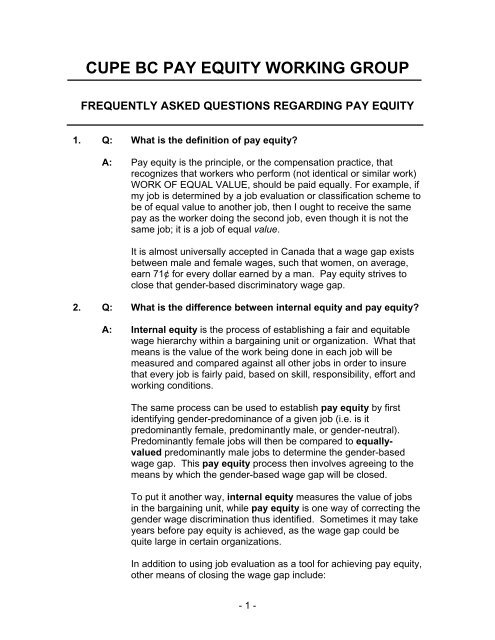Pay Equity questions and answers - CUPE BC
Pay Equity questions and answers - CUPE BC
Pay Equity questions and answers - CUPE BC
Create successful ePaper yourself
Turn your PDF publications into a flip-book with our unique Google optimized e-Paper software.
<strong>CUPE</strong> <strong>BC</strong> PAY EQUITY WORKING GROUP<br />
FREQUENTLY ASKED QUESTIONS REGARDING PAY EQUITY<br />
1. Q: What is the definition of pay equity?<br />
A: <strong>Pay</strong> equity is the principle, or the compensation practice, that<br />
recognizes that workers who perform (not identical or similar work)<br />
WORK OF EQUAL VALUE, should be paid equally. For example, if<br />
my job is determined by a job evaluation or classification scheme to<br />
be of equal value to another job, then I ought to receive the same<br />
pay as the worker doing the second job, even though it is not the<br />
same job; it is a job of equal value.<br />
It is almost universally accepted in Canada that a wage gap exists<br />
between male <strong>and</strong> female wages, such that women, on average,<br />
earn 71¢ for every dollar earned by a man. <strong>Pay</strong> equity strives to<br />
close that gender-based discriminatory wage gap.<br />
2. Q: What is the difference between internal equity <strong>and</strong> pay equity?<br />
A: Internal equity is the process of establishing a fair <strong>and</strong> equitable<br />
wage hierarchy within a bargaining unit or organization. What that<br />
means is the value of the work being done in each job will be<br />
measured <strong>and</strong> compared against all other jobs in order to insure<br />
that every job is fairly paid, based on skill, responsibility, effort <strong>and</strong><br />
working conditions.<br />
The same process can be used to establish pay equity by first<br />
identifying gender-predominance of a given job (i.e. is it<br />
predominantly female, predominantly male, or gender-neutral).<br />
Predominantly female jobs will then be compared to equallyvalued<br />
predominantly male jobs to determine the gender-based<br />
wage gap. This pay equity process then involves agreeing to the<br />
means by which the gender-based wage gap will be closed.<br />
To put it another way, internal equity measures the value of jobs<br />
in the bargaining unit, while pay equity is one way of correcting the<br />
gender wage discrimination thus identified. Sometimes it may take<br />
years before pay equity is achieved, as the wage gap could be<br />
quite large in certain organizations.<br />
In addition to using job evaluation as a tool for achieving pay equity,<br />
other means of closing the wage gap include:<br />
- 1 -
• Using a gender-neutral job evaluation system to measure the<br />
worth or value of jobs;<br />
• Eliminating increments, which are overwhelmingly found in<br />
predominantly-female jobs;<br />
• Ensuring that working conditions exist which facilitate moving<br />
from (predominately-female) part-time or casual work into full<br />
time employment. Such conditions could include flexible<br />
working hours to accommodate child-rearing responsibilities <strong>and</strong><br />
paid family leave.<br />
• Ensuring that working conditions such as flexible hours to<br />
accommodate child-rearing responsibilities, that would facilitate<br />
part-time <strong>and</strong> casual workers (who are predominantly women)<br />
to obtain full-time employment exist;<br />
• Bargaining across-the-board wage increases, rather than<br />
percentage wage increases, which only perpetuate the wage<br />
gap between men <strong>and</strong> women.<br />
These are technical details, <strong>and</strong> courses <strong>and</strong> technical support<br />
for locals is available through the <strong>CUPE</strong> National Job<br />
Evaluation rep, Tania Jarzebiak, in the <strong>BC</strong> Regional Office.<br />
3. Q: Where did the gender-based wage gap originate?<br />
A: Before World War II, there were relatively few women in the<br />
Canadian workforce. The statistical reality was that women tended<br />
to work while they were single, before their marriage, or after a<br />
divorce, when it was necessary to do so to survive. Women were<br />
on the margins, <strong>and</strong> not considered to be a significant part of, the<br />
economy.<br />
With the advent of World War II, the participation rate of women in<br />
the paid economy increased dramatically. Even though they were<br />
considered to be a secondary <strong>and</strong> temporary labour force (that is,<br />
temporary until the war was over), the work being done by women<br />
at that time was not stereotypically female work, but encompassed<br />
the whole range of work that had previously been done – <strong>and</strong><br />
sometimes only allowed to be done – by men.<br />
After the war, women were systematically shut out from many<br />
employment opportunities as employment ads were limited to men,<br />
<strong>and</strong> employers would not even interview women. Their labour force<br />
participation rate, as a result declined. Some 80,000 women were<br />
laid off from good-paying regular full-time government jobs to<br />
create jobs for the men returning from the war, <strong>and</strong>, in 1945, the<br />
prohibition against married women working in the federal public<br />
- 2 -
sector was re-introduced, to create job openings for returning<br />
soldiers. The notion that men needed to earn “a family wage”, <strong>and</strong><br />
that the cultural ideal was for women to resume their “rightful”<br />
position in the home, was widespread, <strong>and</strong> justified such blatant<br />
economic discrimination.<br />
By the 1950’s more women were working, but it was clear they<br />
were not earning the same levels of income as men in comparable<br />
positions, on any measure of comparison. Reasons given for this<br />
disparity included the fact that there were few jobs requiring<br />
“traditional feminine skills” that paid well; women were<br />
disproportionately represented in part-time employment; <strong>and</strong><br />
women were disproportionately concentrated in the leastorganized,<br />
lowest-skilled <strong>and</strong> lowest-paid types of employment<br />
which, at that time, included positions such as nurse, teacher, caregiver,<br />
laundry worker <strong>and</strong> domestic. Women were segregated into<br />
jobs for which the nurturing aspects of being a wife, mother <strong>and</strong><br />
housekeeper, were thought to have prepared them. The<br />
segregation of women in lower paying jobs was accepted even to<br />
the point where collective agreements had sex-specific wage<br />
schedules!<br />
By the 1960’s, salary scales became integrated, <strong>and</strong> most<br />
employment ads now read “help wanted” rather than “men wanted”<br />
or “women wanted”, but the reality was that sex-based occupational<br />
segregation <strong>and</strong> wage disparities continued, even with the<br />
increase, from the 60’s through the 80’s, of women’s labour force<br />
participation in paid labour.<br />
The misconception, but widespread notion, that women’s wages<br />
were supplemental, rather than essential, also contributed to the<br />
under-valuation of predominantly female jobs. This systemic<br />
discrimination was justified on the basis that women didn’t really<br />
“need” a fair wage, as their earnings were “extra” income to that of<br />
their husb<strong>and</strong>s, who were the bread winners responsible for their<br />
wives <strong>and</strong> children.<br />
Underst<strong>and</strong>ing the history that gave rise to the current wage gap, it<br />
is important to underst<strong>and</strong> that pay equity seeks to remedy this<br />
historical wage inequity, <strong>and</strong> is thus a mainstream equality issue.<br />
Just as fair-minded trade unionists would be aghast if wages for<br />
jobs traditionally performed by a particular racial or ethnic group<br />
were underpaid, for reasons that had absolutely nothing to do with<br />
the nature of the job itself but everything to do with the person<br />
performing it, so too must the need for gender-based pay equity be<br />
understood.<br />
- 3 -
4. Q: Why is the gender-based wage gap increasing, rather than<br />
decreasing with time?<br />
A: A review of the reports of the Federal <strong>and</strong> <strong>BC</strong> <strong>Pay</strong> <strong>Equity</strong> Task<br />
Forces, as well as the Canadian experience with pay equity<br />
litigation, demonstrates that predominantly female jobs continue to<br />
be undervalued <strong>and</strong> hence underpaid, so that only in those sectors<br />
where firm pay equity systems are in place, has much progress<br />
been made. Otherwise the gender-based wage gap continues to<br />
grow, because of the lack of pay equity legislation, because certain<br />
workers are not covered by the legislation <strong>and</strong> because<br />
implementing pay equity is taking such a long time to achieve.<br />
Prejudicial social attitudes toward the value of work done primarily<br />
by women, <strong>and</strong> the pressures of global competition <strong>and</strong> the “new<br />
capitalism” are all partly responsible for driving down wages in<br />
general, <strong>and</strong> women’s wages in particular.<br />
5. Q: Why haven’t we been able to eliminate the gender-based wage<br />
gap through collective bargaining?<br />
A: In the last 25 years of collective bargaining, while <strong>CUPE</strong> has had<br />
successes with individual employers, it has been unable to close<br />
the gender-based wage gap in many of its sectors. Indeed, the<br />
recent struggles of <strong>CUPE</strong>’s library workers in Vancouver <strong>and</strong><br />
Victoria indicate just how difficult the bargaining of pay equity can<br />
be! The financial costs of litigating pay equity have been difficult for<br />
the labour movement to meet, while Employers seem to have more<br />
money to fight pay equity than to provide for pay equity!<br />
In its 2004 Final Report, the federal <strong>Pay</strong> <strong>Equity</strong> Task Force devoted<br />
an entire chapter to “<strong>Pay</strong> <strong>Equity</strong> <strong>and</strong> Collective Bargaining”, <strong>and</strong><br />
concluded as follows:<br />
“The goal of achieving pay equity cannot, in our view, be as<br />
effectively pursued through existing traditional bargaining<br />
relationships, as it can through a new structure which will place<br />
the fundamental right of all women workers at the centre,<br />
whether they are represented by a strong trade union, a weak<br />
trade union, or no trade union at all.” (Emphasis mine)<br />
In many cases where <strong>CUPE</strong> has been successful in negotiating pay<br />
equity, employers have often reneged on what they agreed to at the<br />
bargaining table, by vigorously undermining <strong>and</strong> challenging at<br />
arbitration any interpretation of pay equity other than the very<br />
narrowest.<br />
- 4 -
6. Q: Why should st<strong>and</strong>-alone pay equity legislation be supported?<br />
A: The Federal <strong>Pay</strong> <strong>Equity</strong> Task Force considered different legislative<br />
models to achieve pay equity, such as pay equity provisions<br />
contained within existing human rights legislation <strong>and</strong> st<strong>and</strong>-alone,<br />
or separate, pay equity legislation.<br />
It concluded that eliminating wage discrimination is substantially<br />
different from some of the other types of discrimination contained in<br />
human rights legislation because of the technical, procedural <strong>and</strong><br />
strategic issues involved in eliminating the wage gap.<br />
They therefore recommended that the most effective way to<br />
address wage discrimination is specialized “st<strong>and</strong>-alone”<br />
legislation, a position which <strong>CUPE</strong> <strong>BC</strong> has adopted in its pay equity<br />
position paper.<br />
<strong>CUPE</strong>’s position is that pay equity legislation is needed, <strong>and</strong> should<br />
be supported because:<br />
a) pay equity is fundamentally an issue of discrimination against<br />
women, <strong>and</strong> a tool that attempts to remedy that discrimination;<br />
b) in the course of 25 years of collective bargaining, <strong>CUPE</strong>, like<br />
most unions, has been unable to close the gender-based wage gap<br />
in many of its sectors;<br />
c) where <strong>CUPE</strong> has been successful in bargaining pay equity,<br />
employers have often reneged on what they agreed to at the<br />
bargaining table, by vigorously undermining <strong>and</strong> challenging at<br />
arbitration any interpretation of their pay equity obligations other<br />
than the very narrowest.<br />
d) on the principle that, as trade unionists, “what we desire for<br />
ourselves, we desire for all”, <strong>CUPE</strong> supports broad-based<br />
legislation that applies to both public AND private sector workers,<br />
unionized <strong>and</strong> non-unionized workers, <strong>and</strong> all workers regardless of<br />
their status as full-time, part-time, casual, or auxiliary.<br />
7. Q: Which jurisdictions in Canada have pay equity legislation?<br />
A: <strong>Pay</strong> equity legislation is neither a new, nor a radical idea. It is<br />
significant to note that 8 of the 14 jurisdictions in Canada have<br />
some form of pay equity legislation: Manitoba, Ontario, Quebec,<br />
New Brunswick, Nova Scotia <strong>and</strong> Prince Edward Isl<strong>and</strong> have pay<br />
equity legislation, with the federal <strong>and</strong> Yukon jurisdictions having<br />
pay equity protection in their human rights legislation.<br />
<strong>BC</strong>, Saskatchewan <strong>and</strong> Newfoundl<strong>and</strong> had implemented a form of<br />
administrative pay equity that applies only to their public service<br />
- 5 -
employees, but which NO LONGER EXISTS. Thus, pay equity is a<br />
widely-accepted legal remedy for a form of historical discrimination<br />
against women in the majority of Canadian jurisdictions, often via<br />
legislation brought in by Conservative <strong>and</strong> Liberal, as well as the<br />
NDP governments.<br />
8. Q: How is pay equity a remedy for discrimination?<br />
A: As explained in our presentation, the wage gap between men <strong>and</strong><br />
women exists in great part because of the history of under-valuing,<br />
<strong>and</strong> therefore under-paying, work traditionally done by women or<br />
that continues to be done predominantly by women. <strong>Pay</strong> equity<br />
attempts to end this gender-discrimination by achieving equal<br />
wages for equally-valued work, based on skill, effort, responsibility<br />
<strong>and</strong> working conditions.<br />
9. Q: What is the <strong>BC</strong> government’s position on pay equity <strong>and</strong> why<br />
do we not have pay equity legislation?<br />
A: In 2002 the New Democratic Party government introduced an<br />
amendment to the <strong>BC</strong> Human Rights Code that allowed individuals<br />
to initiate pay equity complaints. However, the current Liberal<br />
government eliminated that legislation <strong>and</strong> established a <strong>Pay</strong> <strong>Equity</strong><br />
Task Force which made its report on February 28, 2002. The Task<br />
Force recommended that the government immediately <strong>and</strong><br />
effectively enforce equal pay for equal work, which has been<br />
contained in our <strong>BC</strong> Human Rights legislation for decades <strong>and</strong><br />
which falls far short of pay equity, since it is concerned only with<br />
“similar or substantively similar jobs.” It also proposed studying<br />
specific industries in the province, to address what it saw as the<br />
unique pattern of sex-based wage disparities in each sector. In<br />
other words, the current government did NOT support any form of<br />
pay equity other than the very limited protection that has done<br />
nothing to eliminate the gender-based wage gap.<br />
Since the elimination of the pay equity provision in our human rights<br />
legislation, neither the government of the day, nor the NDP<br />
opposition has seen fit to initiate pay equity legislation.<br />
10. Q: Who will enforce <strong>and</strong> pay for pay equity?<br />
A: As is the case with the enforcement of all human rights, <strong>and</strong> the<br />
setting up of a bureaucratic structure necessary to ensure such<br />
enforcement, a pay equity program will be paid for by the<br />
government, <strong>and</strong> is usually administered by an independent<br />
commission or tribunal.<br />
- 6 -
11. Q: What are the social costs of the lack of pay equity legislation?<br />
A: When male <strong>and</strong>/or female workers who work in predominantly<br />
female jobs are unfairly paid, it is not only that their wages are<br />
undervalued but the full range of wage-related benefits, including<br />
pensions, are negatively affected, perpetuating a cycle of women’s<br />
poverty.<br />
In <strong>BC</strong>, U<strong>BC</strong> professors Gillian Creese, Director of the Center for<br />
Women <strong>and</strong> Gender Studies, Sociology <strong>and</strong> Veronica Strong-Boag,<br />
professor in Educational Studies <strong>and</strong> Women’s Studies, conducted<br />
a study entitled “Still Waiting for Justice: Provincial Policies <strong>and</strong><br />
Gender Inequality in <strong>BC</strong> 2001-2008”. That study, conducted by<br />
credible high-profile experts, illustrates the devastating impact of<br />
the governmental policies from 2001-2008 on women in the<br />
province <strong>and</strong> the dire need for, among other things, pay equity<br />
legislation.<br />
(Note: Presenters have all been given a copy of this excellent<br />
report)<br />
12. Q: Is pay equity bad for men?<br />
A: <strong>Pay</strong> equity is not bad for men! It is beneficial for those men who<br />
choose to work in traditionally predominantly female jobs, since pay<br />
equity compensates persons whose jobs have been under-valued<br />
regardless of the person’s gender. It is also beneficial for any man<br />
that has a mother, wife, sister or child in his family who works in a<br />
traditionally-female job, since the wage increase that pay equity will<br />
bring will add to the family’s income. Perhaps most importantly,<br />
it is good for all men who seek to live in a discrimination-free<br />
society!<br />
13. Q: Is pay equity bad for the employer?<br />
A: This is like asking “was the abolition of slavery bad for the<br />
plantation owner?” Employers whose interest is in making profits,<br />
or trying to operate a service with inadequate funding, will most<br />
always argue that anything that costs them more money is “bad”.<br />
Whenever any equity-seeking group, including women, has sought<br />
equality in the workplace, this is one of the first arguments they<br />
hear.<br />
It is no longer controversial in mainstream Canada, that a<br />
significant wage gap exists between work traditionally done by<br />
women, <strong>and</strong> that traditionally done by men. People (of both sexes)<br />
- 7 -
are paid lower wages based on nothing other than the genderpredominance<br />
of the job. This is sex-based discrimination <strong>and</strong> a<br />
breach of one of the most fundamental of human rights. As a<br />
Union, we simply cannot condone it.<br />
14. Q: How does pay equity affect our pension?<br />
A: When women’s work is under-valued, not only do they receive less<br />
money in their pay cheque, but it also negatively impacts the<br />
amounts of compensation they receive for vacation pay, bonuses,<br />
pension plan, <strong>and</strong> any workplace benefits that are tied to one’s pay.<br />
15. Q: Why don’t we just bargain pay equity?<br />
A: <strong>CUPE</strong>, like other unions in the province, has been successful in<br />
achieving pay equity in certain sectors, generally those sectors<br />
where the wage gap was not that huge to begin with. However, <strong>BC</strong><br />
unions have not been successful across the board in achieving pay<br />
equity for members, <strong>and</strong> the cost of fighting pay equity has been a<br />
significant financial <strong>and</strong> energy drain on the unions resources. In<br />
addition, the time involved in litigating pay equity claims has been a<br />
serious detriment to the achievement of pay equity. Even if we<br />
were successful in bargaining pay equity for our members, since<br />
we believe that “what we desire for ourselves, we desire for all”, it is<br />
essential that the thous<strong>and</strong>s of under-paid workers not lucky<br />
enough to be unionized, also deserve fair <strong>and</strong> equitable pay for the<br />
work that they do.<br />
16. Q: How do we attain pay equity legislation?<br />
A: We attain pay equity legislation through increasing public<br />
awareness about pay equity as a fundamental human right; by<br />
building coalitions within the labour movement <strong>and</strong> in the broader<br />
community, <strong>and</strong> by relentless lobbying of politicians at every level.<br />
:df/dd-cope*491<br />
G:\Representatives\KILFOIL, CONNI\<strong>Pay</strong> <strong>Equity</strong>\2008\Q&A <strong>Pay</strong> <strong>Equity</strong> Legislation july 7 08.doc<br />
- 8 -












